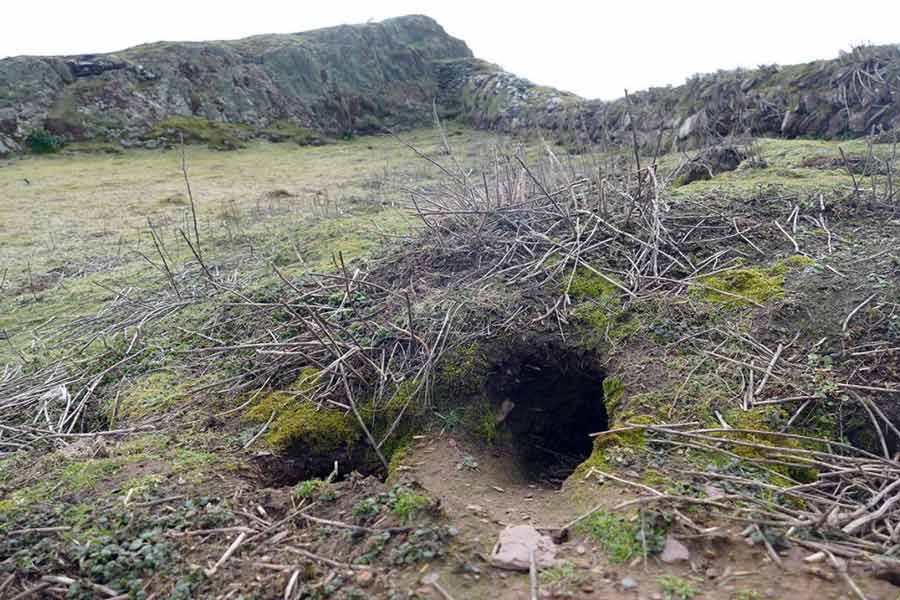Burrowing Rabbits Discover Priceless Artifacts On Skokholm Island
On uninhabited Skokholm Island, two miles off the coast of Wales, burrowing rabbits dug out two Stone Age tools and one Bronze Age piece of pottery. Although it was the Skokholm bunnies that unearthed these treasures, these finds have created enormous excitement in the archaeology community.
The Rabbit Burrow Find and Skokholm Island History
Skokholm Island is uninhabited today, except for two bird researchers Richard Brown and Giselle Eagle, who have lived on Skokholm since 2013. Lockdown isolation was nothing new to them. The pair discovered the objects next to a rabbit burrow and sent photos to archaeologists to confirm the finding.

Skokholm Island lighthouse, home of Richard Brown and Giselle Eagle, who found the treasures the rabbits had unearthed. (Erni / Adobe Stock)
Skokholm Island is small, covering an area of 1 mile by ½ mile (1.6 km by 0.8 km). Previous to the recent Brown and Eagle finds, hardly any archaeological evidence had been found on the island. Therefore, these rabbit burrow finds will help in understanding the island’s obscure history.
- 9,000 Year Old Bones of Oldest Residents of England Found
- British Archaeologists Find First Ever Evidence of Cremation in Mesolithic era
During the late 10th to early 11th century AD, Vikings settled on the island. The name Skokholm is Norse for “wooded island.” From the 14th to 16th centuries, it was used as a rabbit farm and many descendants of these rabbits still live on the island today. Paul Murphy’s article “Medieval Rabbit Farming and Bannow Island” details the importance of rabbits in medieval societies: “Rabbit fur, being soft, durable, and warm, was a desirable material for lining clothing, and their meat was elite eating, as well.”
It was common for medieval societies to breed and raise rabbits on islands, as the location offered isolation and thus protection from mainland predators. Multiple islands in this region have a history of Norman rabbit farming during the medieval period.
But the recent “rabbit burrow” finds on the island provide entirely new insights into the deeper past of the island.

The late Mesolithic “beveled pebble” tool, dated to between 6000 and 9000 years old, is the first ever evidence of hunter-gatherer occupation on Skokholm Island. (Richard Brown and Giselle Eagle / WTSWW)
Skokholm Island’s Priceless Stone and Bronze Aged Treasures
Experts believe the tools found by Brown and Eagle are prehistoric and date to 6,000 to 9,000 years ago, during the Mesolithic period. The first discovery was a beveled pebble that was likely used on seal skin-clad boats or in the preparation of shellfish.
Archaeologist Dr Toby Driver, who was emailed by the island’s residents about the find, enlisted the advice of an expert in prehistorical tools, Dr Andrew David. Dr David stated, “The photos were clearly of a late Mesolithic (Middle Stone Age) ‘beveled pebble’, a tool thought to have been used in tasks like the preparation of seal hides for making skin-clad watercraft, or for processing foods such as shellfish, among hunter-gatherer communities some 6000-9000 years ago.”
Days after discovering the Mesolithic tools, wardens Brown and Eagle, the island’s only human inhabitants, returned to examine the rabbit hole again. This time they noticed a piece of broken pottery protruding from the earth near the burrow.
The fragment is likely part of an urn used in ancient cremation burials. The pottery is thick and has decorative lines running around the top. The archeologists believe it is from the early Bronze Age, roughly 3,750 years ago.

The decorated fragment of a 3700 year old early Bronze Age vase urn is the first Bronze Age pottery ever found in the western Pembrokeshire Islands (Richard Brown and Giselle Eagle / WTSWW).
Jody Deacon, prehistoric archaeologist at the National Museum Wales confirmed the piece of pottery was from the early Bronze Age. She also noted that this was the first evidence of such urns on Skokholm Island and the surrounding Pembrokeshire Islands.
- Enigmatic Engraved Pendant from Stone Age Site is the Oldest in Britain
- The Where, When and How of Quarrying Stonehenge 'Bluestones' Is Revealed in New Report
Richard Brown and Giselle Eagle commented on their findings on their website on March 19th via Livescience:
"It is rather mind blowing that for thousands of years, people have returned to this same area, some of them perhaps working at seal skins, perhaps building skin boats, others burying their dead.”
The Importance of These Finds
These finds have created hope that there are hidden burial mounds on Skokholm Island. The Royal Commission of Wales is preparing plans to partake in archaeological work over the summer on the island. Archaeologist Toby Driver is hopeful about future finds on these remote islands:
"It seems we may have an early Bronze burial mound built over a Middle Stone Age hunter-gatherer site, disturbed by rabbits…It's a sheltered spot, where the island's cottage now stands, and has clearly been settled for millennia."
The discovery of these tools and pottery could be the beginning of further prehistoric discoveries on Skokholm Island and other nearby islands.
Top Image: The rabbit hole which produced the prehistoric finds on Skokholm Island. Source: Richard Brown and Giselle Eagle, WTSWW / Royal Commission RCAHMW).
By Sarah Piraino
References
https://www.medievalists.net/2020/09/medieval-rabbit-farming/
http://skokholm.blogspot.com/2021/03/the-highlight-of-day-which-got-ever.html
https://www.livescience.com/rabbits-dig-up-uk-artifacts.html
https://www.smithsonianmag.com/smart-news/prehistoric-tools-uncovered-wales-bunnies-180977350/
https://rcahmw.gov.uk/lucky-finds-from-rabbit-hole-re-write-prehistory-of-welsh-island/



















